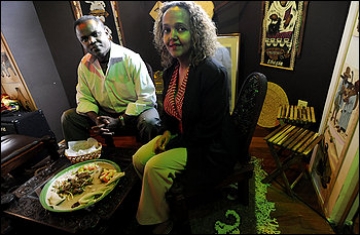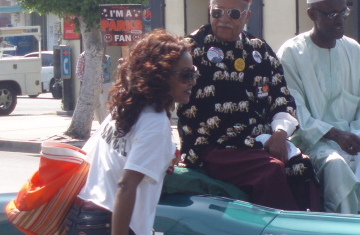
Above: Yehune and Tutu Belay take a seat in their new
restaurant, which is decorated with imported arts and
crafts. (Photos By Lois Raimondo — The Washington Post)
WaPo
By Tom Sietsema
Wednesday, May 20, 2009
The co-owner of the Ethiopian Yellow Pages of the Washington area estimates there are more than 45 dining rooms serving doro wot and injera. So how does Yehune Belay, who just added the title of restaurateur to his résumé, hope to distinguish his place in Shaw from the pack? By re-creating the atmosphere of an Ethiopian home, he says. Read more.
Related from Tadias archives: Little Ethiopia in LA: How it happened

Tadias Magazine
By Azeb Tadesse & Meron Ahadu
A perspective from the people behind the idea
Los Angeles (Tadias) – By now, most people have heard of Little Ethiopia in Los Angeles, a place named for its unique ability to put forward a serving of Ethiopia. Along with the news, there have been many speculations on how this event came about and what it took to visibly acknowledge the essence of the area. As with most things in this world, Little Ethiopia began as a notion. Over a 10-year period, a number of Ethiopian restaurants and specialty store businesses slowly began to relocate to a strip on Fairfax Avenue. The neighborhood was soon transformed from an abandoned boarded up drive-by strip into a hub for community life, buzzing with colors, aroma, and affability of Ethiopian’s ancestral home. As years passed, Ethiopians and Angelinos began to label the area as “Little Addis”, “Little Ethiopia”, and “Ethiopian Restaurant Row”.
The notion began to take hold after PBS aired a segment of Huell Howeser’s popular “Our Neighborhood” show entitled “Little Ethiopia”. Meron Ahadu, co-author of this article, was the tour guide for that segment and the show got its title from the fact that the strip offered visitors a slice of Ethiopia.
The chain of events that led to the fruition of Little Ethiopia began when Meron Ahadu and Tirsit Asrat organized a fundraising for Congressman Mervyn Dymally, who played a key role in the mid 80’s in helping Ethiopians get amnesty. At the time, he was running for a seat in the California State Assembly. Unfortunately, the turnout by the Ethiopian community was disappointing. Nonetheless, it was at this event that the idea of Little Ethiopia was put forth and the Congressman pledged his support.
Five women came together to plan another benefit for the Congressman with a goal to get better participation from the Ethiopian community. It was at this time that the need became apparent to form a non-partisan organization that stood for an increased involvement of the Ethiopian community in the U.S. democratic process. Hence, the Ethiopian-American Advocacy Group (EAAG) was established. In addition to raising funds for Congressman Dymally, the function held on July 26, 2002 was the launching ceremony of EAAG. Various city and state officials attended this highly successful event. One of the short- term projects presented at this occasion was Little Ethiopia and it won the support of Herb Wesson, Speaker of the House for the California State Assembly, and Councilman Nate Holden of District 10, where Little Ethiopia was proposed to be located.
On August 7, 2002, the motion to name Little Ethiopia was presented to the Los Angeles City Council. Consequently, as a result of aggressive lobbying of several political personalities by EAAG members, the City Council voted unanimously to designate the area on Fairfax Avenue, between Olympic and Pico, as Little Ethiopia. The enormous support and candid enthusiasm of the City Council members and the larger Ethiopian community came as a pleasant surprise to many, even to those who worked on the project. A highly successful street festival organized by the community followed on November 24, 2002, to inaugurate the area as Little Ethiopia. A one-block stretch of Fairfax was closed to through traffic for a street festival featuring children’s village, cultural dance and music, fashion show and contemporary Ethiopian music. Approximately 5,000 people attended the festival from all walks of life and congratulations were received from around the globe. City officials and community leaders unveiled the sign designating the place as Little Ethiopia and thus the area was renamed bearing Ethiopia’s name.
This event was truly significant in many respects; firstly, this was the first time in the entire history of the United States that a city has recognized an African country by naming an area after it. Secondly, Little Ethiopia is the only place outside of Ethiopia that bears the name of the motherland. As one drives through the area, it is difficult to ignore the official sign designating the area. In that respect, it indicates that Ethiopians have arrived, are here to stay, and have stood up to be counted as vibrant members of the City of Los Angeles. Finally, yet importantly, this is a legacy for the next generation of Ethiopian-Americans. They will not be burdened with the task of establishing their identity but will have a footnote in the history books to refer to as they strengthen and build their presence in the U.S. and aboard.
It is quite overwhelming to realize that a deed at the local level should have such a universal significance. However, this only bears witness to the importance of engaging one’s surrounding, and begs the question: what can be accomplished if we focus on our commonality by setting aside our differences? What could the 65,000 Ethiopians in Southern California do if they join forces? How about the more than 500,000 Ethiopians in the U.S.? Better yet, what could a coalition of a couple of million African immigrants accomplish? EAAG hopes we will find out in our lifetime.
Related from Tadias Magazine: In Pictures: The Street Named
Little Ethiopia in L.A.


























